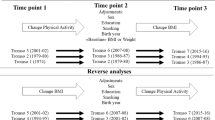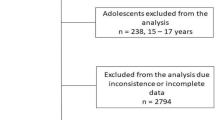Abstract
Physical inactivity is an important risk factor for many chronic diseases. The purpose of this study was to investigate the cross-sectional associations between walking and body mass index (BMI). This study comprised 9991 adults (5723 women), aged 37.8±9.5 years, from the 2004 Azorean Physical Activity and Health Study. Walking was assessed with the International Physical Activity Questionnaire, and expressed as minutes per week. BMI was calculated from self-reported weight and height. A series of multilevel linear regression models were fitted to assess regression coefficients and s.e. predicting BMI. Results show that, in both genders, and after adjustments for potential confounders, walking was not a significant predictor of BMI. Therefore, our analysis does not extend the findings of earlier studies as it shows no significant associations between walking and BMI, after adjustments for potential confounders. Nevertheless, among Azoreans walking should be encouraged, as walking has other health benefits, beyond controlling obesity.
This is a preview of subscription content, access via your institution
Access options
Subscribe to this journal
Receive 12 print issues and online access
$259.00 per year
only $21.58 per issue
Buy this article
- Purchase on Springer Link
- Instant access to full article PDF
Prices may be subject to local taxes which are calculated during checkout
Similar content being viewed by others
References
ACSM (1998). The recommended quantity and quality of exercise for developing and maintaining cardiorespiratory and muscular fitness, and flexibility in healthy adults. Med Sci iSports Exerc 30, 975–991.
Bernstein MS, Costanza MC, Morabia A (2004). Association of physical activity intensity levels with overweight and obesity in a population-based sample of adults. Prev Med 38, 94–104.
Browning RC, Kram R (2005). Energetic cost and preferred speed of walking in obese vs normal weight women. Obes Res 13, 891–899.
Guo SS, Zeller C, Chumlea WC, Siervogel RM (1999). Aging, body composition, and lifestyle: the Fels Longitudinal Study. Am J Clin Nutr 70, 405–411.
Hamer M, Chida Y (2008). Walking and primary prevention: a meta-analysis of prospective cohort studies. Br J Sports Med 42, 238–243.
Haskell WL, Lee IM, Pate RR, Powell KE, Blair SN, Franklin BA et al. (2007). Physical activity and public health: updated recommendation for adults from the American College of Sports Medicine and the American Heart Association. Circulation 116, 1081–1093.
Hills AP, Byrne NM, Wearing S, Armstrong T (2006). Validation of the intensity of walking for pleasure in obese adults. Prev Med 42, 47–50.
Murphy MH, Nevill AM, Murtagh EM, Holder RL (2007). The effect of walking on fitness, fatness and resting blood pressure: a meta-analysis of randomised, controlled trials. Prev Med 44, 377–385.
Nelson MC, Gordon-Larsen P, North KE, Adair LS (2006). Body mass index gain, fast food, and physical activity: effects of shared environments over time. Obesity (Silver Spring, MD) 14, 701–709.
Santos R, Aires L, Santos P, Ribeiro JC, Mota J (2008). Prevalence of overweight and obesity in a Portuguese sample of adults: results from the Azorean Physical Activity and Health Study. Am J Hum Biol 20, 78–85.
Thompson DL, Rakow J, Perdue SM (2004). Relationship between accumulated walking and body composition in middle-aged women. Med Sci Sports Exerc 36, 911–914.
Vaz de Almeida MD, Graca P, Afonso C, D'Amicis A, Lappalainen R, Damkjaer S (1999). Physical activity levels and body weight in a nationally representative sample in the European Union. Public Health Nutr 2, 105–113.
Acknowledgements
This study was sponsored by the Azorean Government—Department of Sports and by the Portuguese Foundation for Science and Technology (PIHM/ESP/49737/03). RS is supported by FCT: BD/22587/2005.
Disclaimer: The findings and conclusions in this report are those of the author(s) and do not necessarily represent the views of the Centers for Disease Control and Prevention.
Author information
Authors and Affiliations
Corresponding author
Additional information
Contributors: RS analysed the data and wrote the paper. MP, JCR, MPS and JC PhD wrote the paper. JM, PhD wrote the paper and conceived and designed the study.
Rights and permissions
About this article
Cite this article
Santos, R., Pratt, M., Ribeiro, J. et al. Walking and body mass index in a portuguese sample of adults: a multilevel analysis. Eur J Clin Nutr 63, 1260–1262 (2009). https://doi.org/10.1038/ejcn.2009.47
Received:
Revised:
Accepted:
Published:
Issue Date:
DOI: https://doi.org/10.1038/ejcn.2009.47



